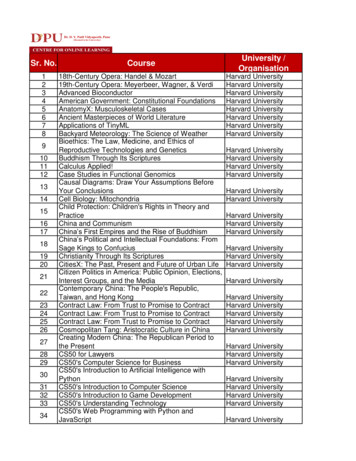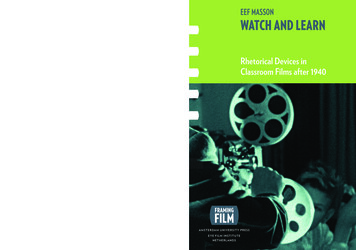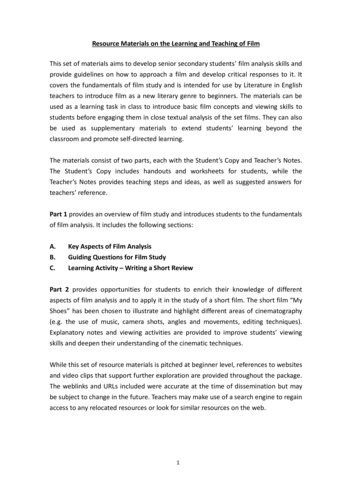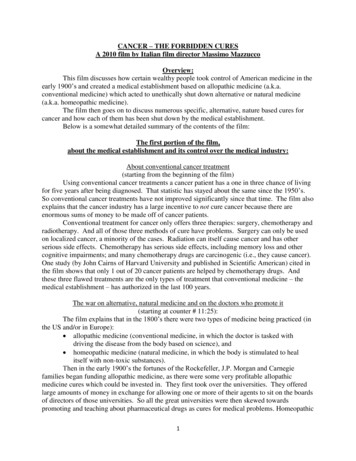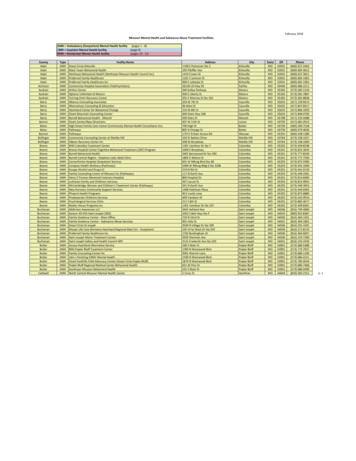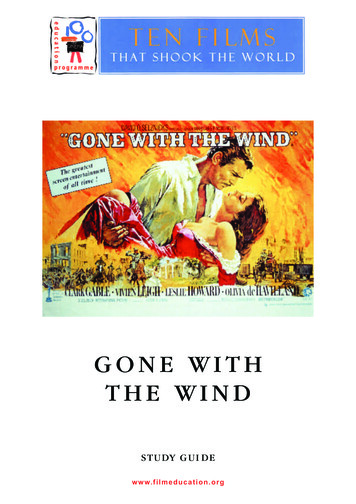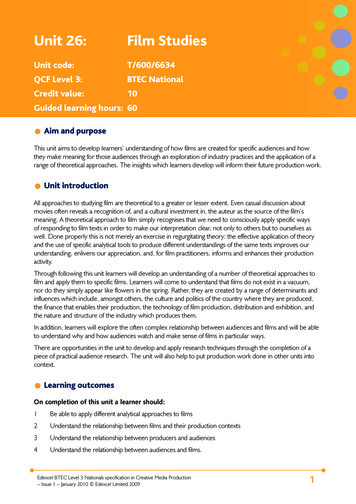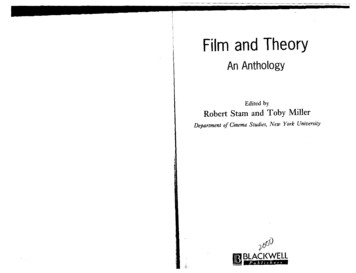
Transcription
Film and TheoryAn AnthologyEdited byRobert Starn and Toby MillerDepartment of Cinema Studies, New York UniversityIiiiII2fJrfJ11 BlACI WELlPublishers
10Questions of GenreSteve Neale;rhis article will discuss some of the issues, concepts, and concerns arising from ork on film genres published over the last decade or so. It seeks to highlight anumber of questions and problems that may pinpoint some possible directions for(pture research. I will be particularly concerned with the constitution of genericf orpuses the extent to which they are constituted by public expectations as well. by films, and the role of theoretical terms, on the one hand, and industrial anditutional terms, on the other, in the study of genres. The concept of verisi itude is central to an understanding of genre, as is the question of the sociald cultural functions that genres perform. These, too, will be discussed. 'oughout I shall stress the changing, and hence historical, nature, not just ofiJ'idividual genres, but of generic regimes as well.'tJ I shall be referring to several books and articles (thus, to some extent, this piece serve as an extended review). But at a number of key points I shall be takingcue, explicitly or otherwise, from an article by Alan Williams entitled "Is aRadical Genre Criticism Possible?" (an article that is itself a review of Thomas;§cbatz's Hollywood Genres and, to some extent, of my own book, Genre).1Despite, or perhaps because of, the fact that it raises so many fundamentalquestions, Williams's article has not been discussed as much as it deserves. In ying this, however, I should note that, insofar as I shall be concentrating here, 01) American cinema and American genres, I shall be ignoring (or at least settingto one side) one of Williams's most important points - that "'genre' is nott xl;lusively or even primarily a Hollywood phenomenon" and that "we need to('get out of the United States.,,2 I concentrate on American cinema partly because,as Williams himself notes elsewhere in his article, there is still an enormous.amount ofresearch to be done on what is still the most powerful national cinemai the world, and partly because most of the work published on genre to date has" ded overwhelmingly to concern itself with Hollywood. In order to engage withis work, it is necessary to engage with its object. However, I should like to note"fl10 that a number of the more general, conceptual points I wish to make areequally applicable to film genres in India or Japan or Italy or Britain.iiyI';
158Expectation and VerisimilitudeThere are several general, conceptual points to make at the outset. The first isthat genres are not simply bodies of work or groups of films, however classified,labeled, and defined. Genres do not consist only of films: they consist also, andequally, of specific systems of expectation and hypothesis that spectators bringwith them to the cinema and that interact with films themselves during thecourse of the viewing process. These systems provide spectators with a means ofrecognition and understanding. They help render films, and the elements withinthem, intelligible and therefore explicable. They offer a way of working out thesignificance of what is happening on the screen: why particular events and actionsare taking place, why the characters are dressed the way they are, why they look,speak, and behave the way they do, and so on. If, for instance, a character in afilm bursts into song for no reason (or no otherwise explicable reason), thespectator is likely to hypothesize that the mm is a musical, a particular kind offilm in which otherwise unmotivated singing is likely to occur. These systemsalso offer grounds for further anticipation. If a film is a musical, more singing islikely to occur, and the plot is likely to follow certain directions rather thanothers.Inasmuch as this is the case, these systems of expectation and hypothesisinvolve a knowledge of - indeed they partly embody - various regimes ofverisimilitude - various systems of plausibility, motivation, justification, andbelief. Verisimilitude means "probable" or "likely.,,3 It entails notions of propri ety, of what is appropriate and therefore probable (or probable and thereforeappropriate).Regimes of verisimilitude vary from genre to genre. (Bursting into song isappropriate, therefore probable - therefore intelligible, therefore believable - in amusical. Less so in a thriller or a war film.) As such, these regimes entail rules,norms, and laws. (Singing in a musical is not just a probability; it is a necessity. Itis not just likely to occur; it is bound to.) As Tzvetan Todorov has insisted, thereare two broad types of verisimilitude applicable to representations: genericverisimilitude and a broader social or cultural verisimilitude. Neither equates inany direct sense to "reality" or "truth":If we study the discussions bequeathed us by the past, we realize that a work is saidto have verisimilitude in relation to two chief kinds of norms. The first is what wecall ru/" oJthe genre: for a work to be said to have verisimilitude, it must conform tothese rules. In certain periods, a comedy is judged "probable" only if, in the last act,the characters are discovered to be near relations. A sentimental novel will beprobable if its outcome consists in the marriage of hero and heroine, if virtue isrewarded ahd vice punished. Verisitoilitude, taken in this sense, designates thework's relation to literary discourse: more exactly, to certain of the latter's subdivi sions Text and IntertextText and Intertextwhich form a genre.159But there exists another verisitoilitude, which has been taken even more fre quently for a relation with reality. Aristotle, however, has already perceived that theverisitoilar i. not a relation between discourse and its referent (the relation of truth),but between discourse and what readers believe is true. The relation is hereestablished between the work and a scattered discourse that in part belongs toeach of the individuals of a society but of which none may claim ownership; inother words, to public opinion. The latter is of course not "reality" but merely afurther discourse, independent of the work.'There are several points worth stressing here. The first is the extent to which,as the example of singing in the musical serves to illustrate, generic regimes ofverisimilitude can ignore, sidestep, or transgress these broad social and culturalregimes.The second is the extent to which this "transgression" of cultural verisimili tude is characteristic of Hollywood genres. This has implications for conventionalnotions of realism. There is, of course, always a balance in any individual genrebetween purely generic and broadly cultural regimes of verisimilitude. Certaingenres appeal more directly and consistently to cultural verisimilitude. Gangsterfilms, war films, and police procedural thrillers, certainly, often mark that appealby drawing on and quoting "authentic" (and-authenticating) discourses, artifacts,and texts: maps, newspaper headlines, memoirs, archival documents, and so on.But other genres, such as science fiction, Gothic horror, or slapstick comedy,make much less appeal to this kind of authenticity, and this is certainly one of thereasons why they tend to be despised, or at least misunderstood, by critics in the"quality" press. For these critics, operating under an ideology of realism, adher ence to cultural verisimilitude is a necessary condition of "serious" film, televi sion, or literature. As Todorov goes on to argue, realism as an ideology can partlybe defined by its refusal to recognize the reality of its own generic status or itsown adherence to a type of generic verisimilitude.A third point to be made is that recent uses of the concept of verisimilitude inwriting on genre tend to blur the distinction between generic and culturalverisimilitude, vitiating the usefulness of the term. Both Christine Gledhill andKathryn Kane, for instance, in writing about melodrama and the war filmrespectively, tend to use "verisimilitude" simply as a synonym for "realism" or"authenticity.,,5 This is a pity because, as both Gledhill and Kane implicitlydemonstrate, melodrama and the war film are genres that often seek to blur thedistinction between the cultural and the generic, and they are often particularlymarked by the tensions between the different regimes.The fourth point is that, at least in the case of Hollywood, generic regimes ofverisimilitude are almost as "public," as widely known, as "public opinion" itself.It is not simply in films or in genres that the boundaries between the cultural andthe generic are blurred: the two regimes merge also in public discourse, genericknowledge becoming a form of cultural knowledge, a component of "publicdpinion."
liiiillI· ll,Text and IntertextText and IntertextFifth, and finally, it is often the generically verisimilitudinous ingredients of afilm, those elements that are often least compatible with regimes of culturalverisimilitude - singing and dancing in the musical, the appearance of themonster in the horror film - that constitute its pleasure and thus attract audi ences to the film in the first place. They too, therefore, tend to be "public,"known, at least to some extent, in advance.These last two remarks lead on to the next set of points, which concern the roleand importance of specific institutional discourses, especially those of the pressand the film industry itself, in the formation of generic expectations, inthe production and circulation of generic descriptions and terms, and, therefore,in the constitution of any generic corpus.of Altman's book, however, is that he devotes the best part of a chapter to thisissue. Most books and articles on genre fail to discuss it at all.)For Altman, the role of industrial and journalistic terms is crucial in establish ing the presence of generic consistencies but of limited use in defining them:160161".j1:1r.,I,LIThe fact that a genre has previously been posited, defined, and delimited byHollywood is taken only as prima facie evidence that generic levels of meaning areoperative within or across a group of texts roughly designated by the Hollywood.' term and its usage. The industrial/journalistic term thus founds a hypothesis about'0!J'Genre and Institutional DiscourseII!!As John Ellis has pointed out, central to the practices of the film industry is theconstruction of a "narrative image" for each individual film: "An idea of the filmis widely circulated and promoted, an idea which can be called the 'narrativeimage' of the film, the cinema's anticipatory reply to the question, 'What is thefilm Iike?,,,6 The discourses of film-industry publicity and marketing playa keyrole in the construction of such narrative images; but important too are othe .institutionalized public discourses, especially those of the press and television,. "'and the "unofficial," "word of mouth" discourses of everyday life.,1Genre is, of course, an important ingredient in any film's narrative image. T eindication of relevant generic characteristics is therefore one of the most impoant functions that advertisements, stills, reviews, and posters perform. Revienearly always contain terms indicative of a film's generic status, while post'usually offer verbal generic (and hyperbolic) description - "The Greate War Picture Ever Made" - as anchorage for the generic iconography in pictori:form.These various verbal and pictorial descriptions form what Gregory Lukow and.Steven Ricci have called the cinema's "intertextual relay.,,7 This relay performs; an additional, generic function: not only does it define and circulate narrative.iimages for individual films, beginning the immediate narrative process of\expectation and anticipation; it also helps to define and circulate, in combination,,;with the films themselves, what one might call "generic images," providing set '''of labels, terms, and expectations that will come to characterize the genre as a,whole.This is a key point. It is one of the reasons why I agree with Lukow and Ricci' ;on the need to take account of all the component texts in the industry's inter ' ,j]textual relay when it comes to studying not only films but genre and genres. And;'it is one of the reasons why I would disagree with Rick Altman, in The Americilt'·Film Musical, on the limited significance he assigns to the role of industrial anl,.journalistic discourses in establishing a generic corpus. 8 (One of the many meritlj',,:'.- the presence of meaningful activity, but does not necessarily contribute a definitionor delimitation of the genre in question."The identification of an industrial/ journalistic term, then, is for Altmanmerely the first step in a multistage process. Having established a preliminaryfurpus in this way, the role of the critic is next to subject the corpus to analysis,to Jocate a method for defining and describing the structures, functions, andsystems specific to a large number of the films within it. Then the critic, usingthis method as a b sis, reconstitutes and redefines the corpus:Texts which correspond to a particular understanding of the genre, that is, whichprovide ample material for a given method of analysis, win be retained within thegeneric corpus. Those which are not illuminated by the method developed in stepthree will simply be excluded from the final corpus. In terms of the musical, this," would mean admitting that there are some films which include a significant amountof diegetic music, and yet which we will refuse to identify as musicals in the strongwhich the final corpus implies. lo. nse.ng thus e tablished a final corpus, the critic is finally in a position to produce,tory of the genre and to analyze "the way in which the genre is molded by,'ons within, and in turn informs the society of which it is a part.,,11:efore explaining my disagreement with this reasoning, it is important to'gnize, along with Altman, that it is not possible to write about genres without.g selective, and that many of the deficiencies of a good deal of writing on, 'e stem from defining and selecting on the basis of pre-established andquestioned canons of films. As Alan Williams points out, this is one of the:, J1tral deficiencies of Schatz's book, in which coverage of any given genre.depends not on historical or theoretical even-handedness but on tacitly agreed-uponlandmarks. Thus the chapter on the musical covers mainly Warner Brothers/Busby'Berkeley, Fred Astaire at RKO, and the Freed Unit at MGM. So where is Lubitschand the operetta? (Maybe the latter is not a "Musical," but Hollywood Cenres does'not explain.) Al Jolson and the crucially important melodramatic musicals of thely sound years? Who decided that these points alone would suffice?"contrast, Altman's book is impressively wide in its range of references and:hingly free from established canons of taste and categorization, including
162Text and IntertextText and Intertextnot only Jolson, operetta, and Lubitsch, but also the Elvis Presley films of thefifties and sixties and films like Grease (Randal Kleiser, 1978) and Flashdancej;'(Adrian Lyne, 1983). It is important to say, too, that I agree with Altman that'l,journalistic and industrial labels rarely, on their own, provide a conceptual baSi.:,for the analysis of genres or for the location of generic patterns, structures, andHsyst :tnS, just as I agree that such analysis is vitally important.Where I disagree, however, is on Altman's assertion that the importance of,"industrial/journalistic terms is restricted to the first step of generic analysis. ('"disagree with this because I do not believe the aim of generic analysis is the",redefinition of a corpus of films. Such an aim is in the end no different, in effect:'"if not in intention, from the highly selective categorizations of Schatz or from the' 'jworst pigeonholing inheritances of neo-classicalliterary theory. We can easily end "up identifying the purpose of generic analysis with the rather fruitless attempt to,·tJ'4'ldecide which films fit, and therefore properly belong to, which genres. We can "also end up constructing Ot perpetuating canons of films, privileging some an ,. demoting or excluding others. (Thus even Altman, despite his broad range an ,,}the power of his method, finds himself excluding films like Dumbo [Ben Sharp,'F1' teen, 1941] and Bambi [David Hand, 1942] and nearly excluding The Wizard oF'Oz [Victor Fleming, 1939].)Such an aim is, therefore, inherently reductive, More than that, it is in dang'of curtailing the very cultural and historical analysis upon which Altman righ'insists as an additional theoretical aim. The danger lies not only in the devaltion of industrial/ journalistic discourses, but in the separation of genre analfrom a number of the features that define its public circulation. These featiinclude the fact that genres exist always in excess of a corpus of works; thethat genres comprise expectations and audience knowledge as well as films; ,.the fact that these expectations and the knowledge they entail are public in sAs Todorov has argued (while himself tending to equate genres solelyworks):CaeOne can always find a property common to two texts, and therefore put th'together in one class. But is there any point in calling the result of such a union ".,"genre"? I think that it would be in accord with the current usage of the word andat the same time provide a convenient and operant notion if we agreed to call'"genres" only those classes of texts that have been perceived as such in the course"of history. The accounts of this perception are found most often in the discourse ongenres (the meta-discursive discourse) and, in a sporadic fashion, in the texts'themselves. 13As far as the cinema is concerned (Todorov here is writing about literatu and High Literature at that), this meta-discursive discourse is to be foundintertextual relay. Qearly, generic expectations and knowledge do notsolely from the film industry and its ancillary institutions; and, clearly, indivi,spectators may have their own expectations, classifications, labels, and terms,'.163·#\:hese individualized, idiosyncratic classifications play little part, if any, in theiIlblic formation and circulation of generes and generic images. In the public. ,here, the institutional discourses are of central importance. Testimony to the'stence of genres, and evidence of their properties, is to be found primarilyere.'A distinction needs to be made, then, between those studies of genres con as institutionalized classes of texts and systems of expectation and thoseies that use critically or theoretically constructed terms as the basis for:tussing classes of films. (Studies of film noir are obvious examples of theer.) A distinction also needs to be made between institutionally recognizedbgenres, cycles, and categories (operetta and the singing Western) and theor ieal or scholarly classifications (the fairy tale musical, the show musical, and the,Ik musical). This is not to argue that theoretical studies and classifications aremehow illegitimate, (Far from it. These examples all illustrate how productive,ey can be.) It is, however, to insist on the pertinence ofTodorov's distinctionor an understanding of what it is that is being studied.Institutional Discourses and Genre History,t, only do industrial and journalistic labels and terms constitute crucial evid for an understanding of both the industry's and the audience's genericptions in the present; they also offer virtually the only available evidencehistorical study of the array of genres in circulation, or of the ways in which.idual ftIms have been generically perceived at any point in time. This is:tant for an understanding of the ways in which both the array and the,tions have changed.;it me give some examples. Both "the Western" and The Great Train Robbery\ jh S. Porter, 1903) are firmly established in genre studies, the latter as anI highly influential example of the former. However, in his Dictionary of ,and Unconventional English, Eric Partridge dates the first colloquial use of,rm Western in anything other than an adjectival sense to around 1910. The se of the term cited in the Oxford English Dictionary with reference to a filmfrom 1912, occurring in a review of The Fight at the Mill (1912) in a July,Issue of the trade magazine The Moving Picture World. This was nine yearsThe Great Train Robbery was released.ow it may be argued, of course, that this is merely quibbling. While the'fie term Western may not have been available to audiences in 1903, Westernslves, in the form of dime novels, Wild West shows, paintings, illustrations,stories, and the like (as well as one or two films), had been around for some14 Thus audiences of The Great Train Robbery, well accustomed to thesei would have drawn on the paradigms they provided in understanding andthe film. Charles Musser, however, has convincingly argued that this wascase, that the paradigms used both by the industry and its audiences were
'IiText and Intertextdifferent and that it was the confluence of paradigms provided by melodrama, thechase film, the railway genre, and the crime film, rather than the Western, tha\ ensured the film's contemporary success:";.2[. Meanwhile, Biograph's "Advance Partial List" of films for sale in 1902 lists itsitsubject" under the following titles and headings: Comedy Views, Sports', d Pastime Views, Military Views, Railroad Views, Scenic Views, Views of!Notable Personages, Miscellaneous Views, Trick Pictures, Marine Views, t:hildren's Pictures, Fire and Patrol Views, Pan-American ExpositionWiews, Vaudeville Views, and Parad\, Pictures. 19 (The number of "documentary"'.pr "actuality" categories here is, of urse, indicative of the extent to which these2 enres far outweighed fiction in the period prior to 1903-4.)In demonstrating the degree to which genre categories and generic regimes ave changed, these examples illustrate the historical character of all genres.7iJienres are inherently temporal: hence, their inherent mutability on the one JiJmd and their inherent historicity on the other. In disagreeing with Altman on"'\e significance of institutional discourses, I now wish to focus attention on a. er aspect of that temporality.Kenneth MacGowan attributed this success . to the fact that the fl1m was "thefrrst important Western," William Everson and George Fenin find it importantbecause it is Hthe blueprint for all Westerns." These, however, are retrospectivereadings. One reason for The Great Train Robbery's popularity was its ability toincorporate so many trends, genres and strategies fundamental to the institution ofcinema at that time. The film includes elements of both re-enactment of contem porary news events (the train hold-up was modeled after recently reported crimes)and refers to a well-known stage melodrama by its title. Perhaps most importantly,The Great Train Robbery was part of a violent crime genre which had been importedfrom England a few months earlier. Porter was consciously working (and cinemapatrons viewing) within a framework established by Sheffield Photo's Daring Day light Burglary, British Gaumont/Walter Haggar's Desperate Poaching Affairand R. W. Paul's Trailed by Bloodhounds. [Thus,] when initially released, TheGreat Train Robbery was not primarily perceived in the context of the Western. Itssuccess did not encourage other Westerns but other films of crime - Lubin's BoldBank Robbery Uack Frawley, 1904], Paley and Steiner's [Avenging a Crime; Or,]Burned at the Stake [1904], and Porter's own Capture of the Yegg Bank Robbers[1904]. It was only when the Western genre emerged as a vital force in the .nickelodeon era that The Great Train Robbery was interpreted from this newperspective. ISMusser's argument here serves to indicate, in addition to the change in gestatus of The Great Train Robbery, the extent to which different periods inhistory of the American cinema have been marked by different generic syste.·different "generic regimes." It is an important theoretical point that genresnot exist by themselves; they are named and placed within hierarchies or syst'of genres, and each is defined by reference to the system and its members.Furthermore, "Each era has its own system of genres." 17 Company cataloguesa particularly useful resource in establishing the generic regimes of the earyears of the cinema. Their terminology and their groupings indicate the consi:able differences between these regimes and the regimes of the studio era. Tinstead of the Westerns, horror films, and war films of later years, the Optical Company's catalogue for 1905 lists films in the following groupings:".165Text and Intertext1642345Story(a) historical(b) dramatic(c) narrativeComicMysteriousScenicPersonalities 18!j.Genre as Processmay at first sight seem as though repetition and sameness are the primaryarks of genres, as though, therefore, genres are above all inherently static.ut as Hans Robert Jauss and Ralph Cohen (and I myself) have argued, genres.c'e, nevertheless, best understood as processes. 20 These processes may, for sure, be minated by repetition, but they are also marked fundamentally by difference,,pntion, and change. The process-like nature of genres manifests itself as an interaction between'ee levels: the level of expectation, the level of the generic corpus, and the levelthe "rules" or "norms" that govern both. Each new genre film constitutes an''dition to an existing generic corpus and involves a selection from the repertoiretgeneric elements available at anyone point in time. Some elements are" Iuded; others are excluded. Indeed, some are mutually exclusive: at most,'inis in its history, the horror film has had to characterize its monster eithermaturally - as in Dracula (Tod Browning, 1930) - or psychologically - as in'cho (Alfred Hitchcock, 1960). In addition, each new genre film tends to extend'epertoire, either by adding a new element or by transgressing one of the oldThus, for instance, Halloween Uohn Carpenter, 1979) transgressed theion between psychological and supernatural monsters, giving its monster,ttributes of both. In this way the elements and conventions of a genre are' ys in play rather than being simply replayed/ 1 and any generic corpus is ys being expanded.Jemories of the films within a corpus constitute one of the bases of generic· tion. So, too, does the stock of generic images produced by advertise ' ; posters, and the like. As both corpus and image expand and change withr,pearance of new films, new advertising campaigns, and new reviews, so also"·(1,
167Text and IntertextText and Intertextwhat Jauss has termed the "horizon of expectation" appropriate to each genr 'expands and changes as well:far as they always tended to combine one type of generic plot, a romance plot,cthers.,6 Moreover, it is at least arguable that many of the most apparently',itte" and stable genres, both inside and outside the cinema, initially evolved by,rnbining elements from previously discrete and separate genres either within or'Oss specific generic regimes. Ernest Mandel, for example, has argued that the"aetective genre emerged in this way by combining three such generically dis ',parate elements: the "reverse story," developed by Godwin (Caleb Williams,14); the divination deduction technique, which originated in Persia and wasduced into modem literature by Voltaire (Zadig); and the coup de theatre,,rrowed from melodrama.'7 Similarly, Richard Traubner has shown, in pains 'ng detail, how operetta emerged by combining the features of opera buffa,rman Singspiel, and British ballad opera and how it subsequently evolved by,lacing some of these features with elements of burlesque and revue; then, inerica at least, these were displaced in turn, until the genre finally emerged ase "musical play" with shows (and fUms) like Show Boat (filmed in 1936 by,es Whale and in 1951 by George Sidney), Oklahoma!, Brigadoon (filmed in1?54 by Vincente Minnelli), Carousel (filmed in 1956 by Henry King), West Side(filmed in 1961 by Robert Wise), and My Fair Lady (filmed in 1964 byorge Cukor).'8Hence the importance of historicizing generic definitions and the parameters,th of any single generic corpus and of any specific generic regime. For it is notthat more elaborate definitions are impossible to provide, just that they are always istorically relative and therefore historically specific. It is not that the processi e nature of genres renders generalizations invalid. Genre films, genres, and, generic regimes are always marked by boundaries and by frameworks, which' lways have limits. Thus even hybrids are recognized as hybrids - combinations",.,, specific and distinct generic components - not as genres in their own right.,c,,;s is why I would prefer not to say, as Jim Collins has recently done, that a. genre text always "remakes" norms, but rather that a genre text always either' fFworks .them, xtends h m, or ans:orms the altogether.)'9 The p int,\. though, IS that tf these hmtts are historically speCific, they can be determmed' nly empirically, not theoretically.166The relationship between the individual text and the series of texts formative of agenre presents itself as a process of the continual founding and altering of horizons.The new text evokes for the reader (or listener) the horizon of expectations and"rules of the game" familiar to him from earlier texts, which as such can then bevaried, extended, corrected, but also transfonned, crossed out, or simply repro duced. 22,j-This is one reason why it is so difficult to list exhaustively the characteristic:,.components of individual genres, or to define them in anything other than the ",most banal or tautological terms: a Western is a film set on the American wester#frontier; a war film is a film that represents the waging of war; a detective film, . :a film about the investigation of criminals
the production and circulation of generic descriptions and terms, and, therefore, '0 in the constitution of any generic corpus. !J' Genre and Institutional Discourse . As John Ellis has pointed out, central to the practices of the film industry is the . construction of a "narrat

